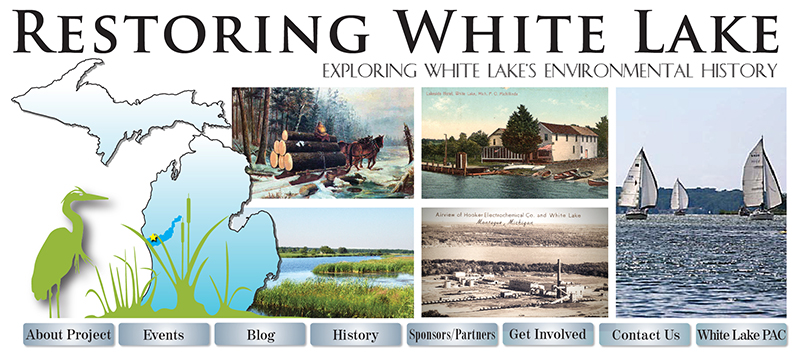A Brief History Of The White Lake Area*
White Lake was formed about 10,000 years ago during the time of the glaciers. Winds helped to create sand dunes that gradually dammed up the river mouth, creating a drowned river mouth lake, which supported a rich and diverse mix of shoreline habitats, such as wetlands and coastal bays.
White Lake covers 2,571 acres, is approximately five and a half miles long, averages a mile in width, and has a mean depth of 23 feet and a maximum depth of 70 feet.
The lake is part of the White River watershed. White River begins in Newaygo County and runs through Oceana County and into Muskegon County, where it enters White Lake and exits to Lake Michigan. The river and lake were named by Native Americans for their white marl bottoms, which made the water look white and cloudy.
Lumbering 1837 - 1900
One of the area’s most significant events was the lumbering era, the impetus for the settlement of the White Lake community. At the height of this era, 16 sawmills ringed White Lake. Logging drastically changed the White River and White Lake. Bark and debris sloughed off logs onto the river bottom, causing sedimentation. Straight channels dug in the coastal marshes to create the log boom area created further problems by decreasing the capacity of the wetlands to reduce nutrient loads, absorb floods, and filter water quality.
Early Industry and the Resort Era (1900 – 1950)
At the turn of the century, the economic focus turned to fruit growing, commercial fishing, leather production, machining, and metal casting. The White Lake area, known as "The Riviera of the West," also became a popular destination for tourists and families arriving via steamboat and passenger train from the Chicago area. Inns and resorts were established around the lake to accommodate this interest.
Manufacturing Era (1950 – 1996)
In the early 1950s, White Lake began its industrial manufacturing era, which, along with increased residential development and municipal discharges, took an ecological toll on White Lake. As a result, in 1985, state and federal environmental authorities designated White Lake as one of 43 "toxic hotspots" or Great Lakes Areas of Concern. Many of the chemical companies responsible for industrial pollution were closed by the mid-1990s.
The Present
The White Lake area now features light industrial and commercial development, recreational marinas, seasonal cottages, retirement living, and permanent homes for its residents. A cleaner White Lake is valued for its beauty and recreational opportunities, a key element of the area’s tourist economy.
* Sources
- Logging the White, Daniel J. Yakes, Ph.D., Steven S. Demos, M.D., 2002
- Remedial Action Plan Update 2002: White Lake Community Action Plan
Navigating the White Lake PAC Pages
Use this table of contents to navigate the various PAC pages. You will find this at the bottom of each PAC page.
- White Lake PAC Welcome
- About The White Lake Area Of Concern
- Restoring White Lake: A Brief History
- Current Status
- About The White Lake Public Advisory Council
- A Brief History of the White Lake Area you are currently on this page
- What Happens After White Lake is Delisted?
- Planning for White Lake’s Future Beyond Delisting
- White Lake PAC Events
- Publications & Videos
- Partners
